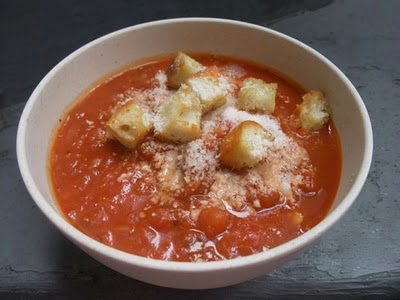
I've started off this year eating more soup. It's amazing what can go in soup. I mean, pretty much anything. And many classic comfort food dishes can be transformed into soup. Macaroni and cheese, baked potato, even eggplant parmesan.
I got the idea to make this soup when I was contacted by Whole Foods about a Parmigiano Reggiano promotion they were planning. I wanted to make something with the flavors of eggplant parmesan, but lighter and healthier. I used a few croutons and roasted the eggplant, instead of breading and frying it and skipped the mozzarella altogether. And you know what? It still pretty much has the flavor of eggplant parmesan! I thought I was being terribly original, but it turns out there are several eggplant parmesan soup recipes out there on the internets.
I topped my soup with a couple tablespoons of Pamigiano Reggiano. It's the cheese that really makes the soup into something special. It adds that distinctive flavor and texture. I'm sorry that you can't see in the photo that the soup has chunks of eggplant in it. You could puree it if you prefer a smoother soup. Also the croutons absorb a good bit of the soup and add even more body to it. Best of all, it's very healthy, so you can help yourself to a second bowl. I won't tell.
Eggplant Parmesan SoupMakes about 6 servings
Ingredients
1 large or 2 small eggplant cut in 1/2 lengthwise (about 2 lbs)
2 Tablespoons extra virgin olive oil
1 medium onion, chopped
3 cloves garlic, minced
1 28 ounce can crushed tomatoes with basil
3 cups water
1/2 teaspoon kosher salt
3/4 cup Parmigiano Reggiano, grated
Croutons
Fresh basil leaves, optional
Instructions
Preheat oven to 450 degrees. Cut eggplant in half, lengthwise and place cut side down on a lightly greased foil-lined broiler pan. Roast for about 45 minutes, or until eggplant is tender. Allow eggplant to cool. Meanwhile heat olive oil in a large dutch oven over medium heat. Add the onions, sauté 5 minutes. Add the garlic and cook for another minute. Scoop out the eggplant from the shells and chop roughly, discard the shells. To the dutch oven add the chopped eggplant along with the tomatoes, water and salt, and bring to a boil over high heat. Reduce heat to low, cover and simmer 20 minutes, stirring occasionally. Top each serving with croutons and two tablespoons of Parmigiano Reggiano. Garnish with torn basil, if desired.
Enjoy!
My thanks to Whole Foods for providing me a gift card and inspiring me to create this recipe



